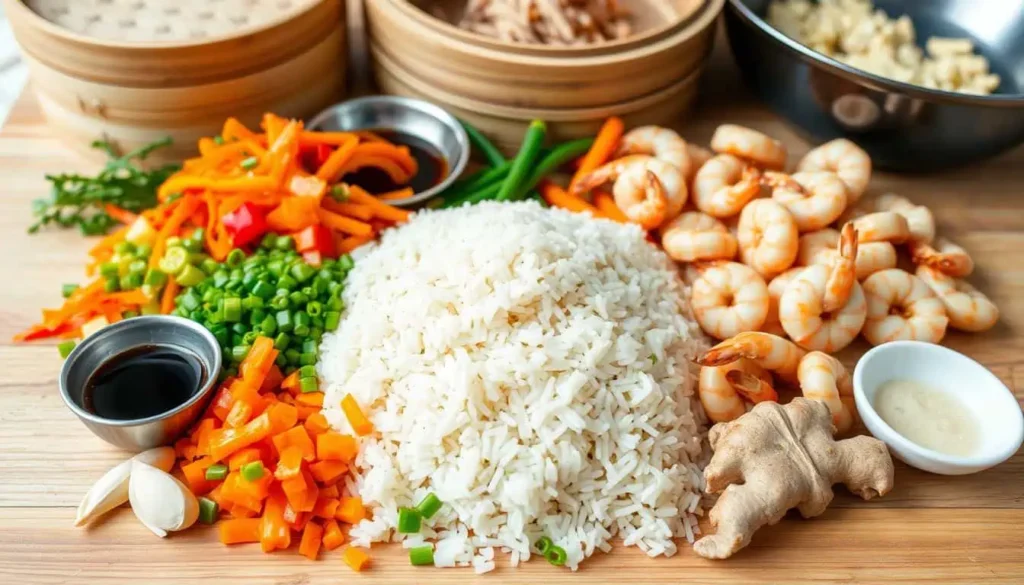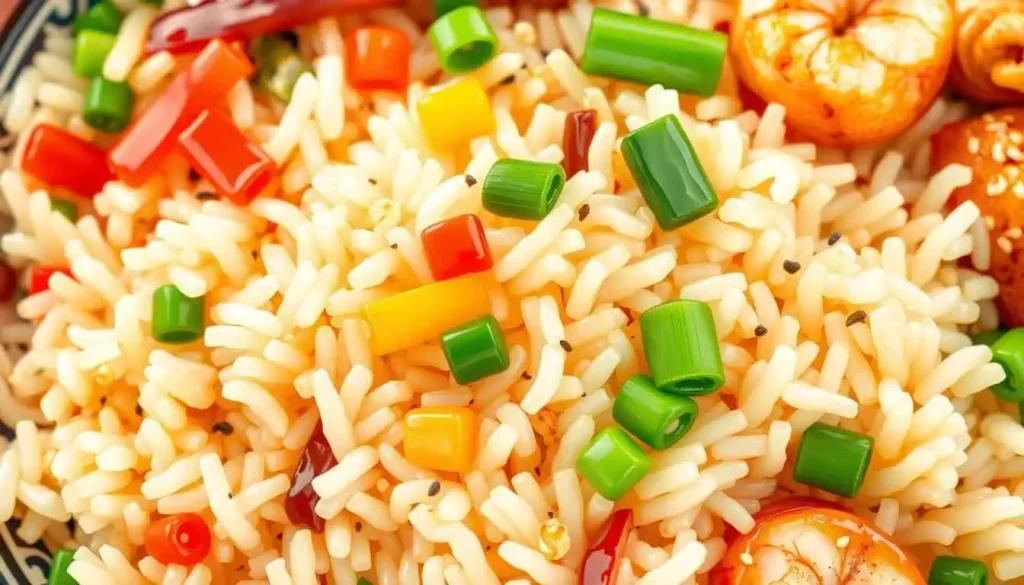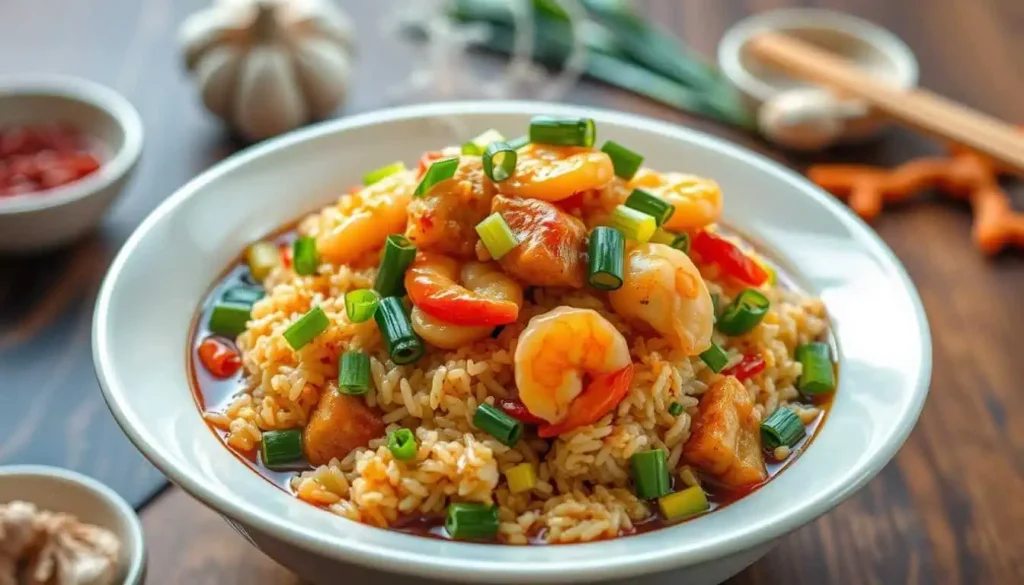Ever wondered what gives Chinese fried rice its flavour? It’s not just a mix of rice and veggies. The magic comes from fresh ingredients, umami seasonings, and expert cooking techniques that bring out the dish’s unique taste.
Key Takeaways
- The secret behind Chinese fried rice lies in its unique blend of fresh ingredients and umami-rich seasonings.
- Cooking techniques play a crucial role in enhancing the flavors of the dish.
- Understanding regional variations can deepen your appreciation for this culinary staple.
- Quality rice is essential for achieving the perfect texture and taste.
- Customizing ingredients can lead to a personal touch that enhances the overall flavour.
Understanding the Foundations of Chinese Fried Rice Flavour
Creating the delightful taste of Chinese fried rice relies on key components. The mix of rice, proteins, and vegetables adds depth and richness. Let’s explore the elements that make this dish so beloved.
Key Components of the Dish
The flavor of fried rice comes from a mix of chinese fried rice ingredients. It often includes meat like chicken, shrimp, or pork, and veggies like peas and carrots. The crunch of veggies and the soft rice create the dish’s base.
Mastering cooking techniques is also crucial. Stir-frying at high heat gives that charred taste we love.
The Importance of Rice Quality
The type of rice used is vital in traditional chinese fried rice ingredients. Day-old rice is best because it’s drier, preventing sogginess. I choose high-quality jasmine or long-grain rice for its fluffy grains.
This rice type absorbs flavors well, making each bite a burst of taste. A great fried rice dish combines all these elements for a truly satisfying experience.

What gives Chinese fried rice its flavour?
When I think about Chinese fried rice, umami is the first thing that comes to mind. This flavor adds depth and richness, often described as savory or meaty. It’s what makes this dish so beloved.
The Role of Umami in Flavour Development
Ingredients like soy sauce, oyster sauce, and mushrooms are key to Chinese fried rice’s flavor. They make the dish taste better and more satisfying. Each ingredient blends together during cooking, creating a mix of flavors that excites the taste buds.
How Cooking Techniques Affect Taste
Cooking techniques are crucial for Chinese fried rice’s taste. Quick cooking at high temperatures keeps the ingredients moist. Stir-frying ensures even cooking and adds flavor and texture. This method brings out the umami, making the dish a feast for the senses.

Understanding these elements helps me make Chinese fried rice that stands out. By focusing on umami and mastering cooking techniques, I create a dish that’s both delicious and memorable.
Essential Chinese Fried Rice Ingredients
Making authentic Chinese fried rice begins with the right ingredients. Knowing the key ingredients leads to a dish that honors tradition and allows for personal touches.
Traditional Ingredients for Authenticity
For a true taste, some ingredients are must-haves. Day-old rice is best because it gives the right texture without being too wet. Here are the main ingredients for tasty fried rice:
- Day-old rice
- Green onions
- Eggs
- Vegetables like peas, carrots, and bell peppers
- Proteins like chicken, shrimp, or tofu
Common Additions to Enhance Flavour
I also add common flavor boosters to my fried rice. The best spices for Chinese fried rice include:
- Garlic
- Ginger
- Soy sauce
- Oyster sauce
- Sesame oil
These additions not only add flavor but also health benefits. Each one helps balance the taste, making the dish irresistible.
| Ingredient | Purpose | Example |
|---|---|---|
| Day-old rice | Textural foundation | Long-grain or jasmine |
| Green onions | Freshness and crunch | Sliced as garnish |
| Eggs | Binding and protein | Scrambled into the rice |
| Proteins | Heartiness | Chicken or tofu |
The Best Seasonings for Chinese Fried Rice
When I make Chinese fried rice, the right seasonings are crucial. They can turn a simple meal into something amazing. Different seasoning blends offer unique flavors, making it easy to customize.
Popular Seasoning Blends
My favorite seasonings include soy sauce, sesame oil, and white pepper. Each adds a special touch to the dish. Here’s a quick look at some top blends:
| Seasoning | Flavor Profile | Usage Tips |
|---|---|---|
| Soy Sauce | Salty, umami | Add early for deep flavor |
| Sesame Oil | Nutty, aromatic | Drizzle at the end for fragrance |
| White Pepper | Spicy, earthy | Use sparingly for a kick |
| Oyster Sauce | Sweet, salty | Mix in for richness |
| Five-Spice Powder | Complex, warm | Sprinkle to elevate dish |
How to Combine Seasonings for Maximum Impact
Layering flavors is essential for a balanced dish. I start with soy sauce for deep flavors. Then, a drizzle of sesame oil before serving adds a great aroma. Finding the right balance lets me adjust the taste to my liking. Playing with amounts can really change the flavor.
Secrets to Flavorful Chinese Fried Rice
Making great fried rice starts with the ingredients. Fresh veggies, herbs, and aromatics are key. They make the dish taste amazing.
Using Fresh Ingredients for Better Taste
I always choose fresh ingredients for my fried rice. They make a big difference in taste. Fresh veggies add color, nutrients, and crunch.
Green onions, peas, and bell peppers are great. They add flavor and look good too.
- Green onions: Add a fresh and slightly sweet taste.
- Bell peppers: Contribute a crunch and can be varied in color for presentation.
- Carrots: Offer sweetness and a pop of color.
- Garlic and ginger: Infuse the dish with aromatic depth.
Customizing Flavours to Your Preference
Chinese fried rice is all about being flexible. I like to add my own twist, like spice or more herbs. This way, I can make it just right.
Here are some tips for delicious Chinese fried rice customization:
- Start with a base seasoning, such as soy sauce or oyster sauce.
- Incorporate spices that you love, like red pepper flakes for heat.
- Add herbs like cilantro or basil for freshness.
- Experiment with protein options, such as shrimp or tofu, to add richness.
By using fresh ingredients and customizing flavors, I make a dish that’s both tasty and personal. My way of making Chinese fried rice keeps it exciting and tailored to my taste every time.
How to Make Chinese Fried Rice Like a Pro
Making homemade Chinese fried rice is an art. It needs preparation, technique, and the right ingredients. I’ll guide you through a step-by-step cooking guide. We’ll focus on delicious flavors and perfect texture.
Step-by-Step Cooking Guide
First, gather your ingredients. You’ll need cooked rice, fresh veggies like peas and carrots, and your choice of protein. Here’s how I start:
- Prepare Rice: Make sure your rice is cold and dry. Day-old rice is best because it has less moisture.
- Chop Ingredients: Cut your veggies and protein into uniform pieces for even cooking.
- Heat the Wok: Use high heat to get your wok hot. This is key for that iconic ‘wok hei’ flavor.
- Cook Protein: Add your protein to the wok and cook until almost done. Then, remove and set aside.
- Sauté Vegetables: Add oil to the wok, then your chopped veggies. Stir-fry until tender.
- Combine Everything: Add cooked rice and protein to the wok. Stir well for even distribution.
- Season: Pour in your chosen sauces, like soy sauce or oyster sauce. Mix well for balanced flavor.
Tips for Achieving the Perfect Texture
Several factors are key for the perfect texture. Avoid overcrowding the pan to get that stir-fried texture. Here are some tips for flavor and texture:
- Use High Heat: Cooking at high temperatures creates crispy edges.
- Don’t Over-Stir: Let the rice sit in the wok for a few moments without stirring. This creates toasted bits.
- Incorporate Aromatics: Adding garlic and ginger at the start enhances flavor without affecting texture.
Enhancing Chinese Fried Rice Taste
Reinventing your Chinese fried rice can be very rewarding. By trying new twists on the classic recipe, you can make it exciting again. This approach brings new life to a beloved dish.
Creative Twists on the Traditional Recipe
Adding your own touch to Chinese fried rice can make it even better. Try using:
- Quinoa instead of rice for a healthier option.
- Cauliflower rice for a low-carb choice.
- Spices like curry or smoked paprika for a unique flavor.
Choosing the Right Proteins and Veggies
Choosing the right proteins and veggies can make your dish stand out. Consider:
- Duck for a rich taste.
- Plant-based proteins like tempeh or tofu for a meatless option.
- Seasonal veggies like asparagus or snap peas for freshness.
These choices not only make your fried rice better but also introduce new flavors. Every bite becomes a new discovery.
| Ingredient Type | Traditional Choices | Creative Options |
|---|---|---|
| Proteins | Chicken, Shrimp | Duck, Tempeh, Tofu |
| Veggies | Carrots, Peas | Asparagus, Snap Peas, Bell Peppers |
| Grains | White Rice | Quinoa, Cauliflower Rice |
Conclusion
Reflecting on Chinese fried rice’s flavour, we see the power of quality ingredients, cooking methods, and seasonings. Each part adds to the authentic taste of Chinese fried rice. This taste is both traditional and personal.
Fresh veggies, proteins, and rich sauces make homemade Chinese fried rice special. They bring out complex and satisfying flavours.
I encourage you to use these insights in your cooking. Try new things in the kitchen. This way, you can keep traditional recipes and add your own twist.
Whether you stick to old ways or try new things, aim to make a dish that you love. It should also show off your unique style.
Making Chinese fried rice at home is a fun journey. It lets us enjoy the many flavours that make this dish loved worldwide. It also lets us create special moments at the dinner table.
FAQ
What gives Chinese fried rice its flavour?
Chinese fried rice gets its taste from top-notch ingredients and seasonings. Soy sauce, oyster sauce, and fresh veggies are key. Mushrooms and meats add a rich umami taste.
What are the essential Chinese fried rice ingredients?
For real Chinese fried rice, you need day-old rice, green onions, eggs, and veggies like peas and carrots. Adding chicken, shrimp, or tofu makes it even better.
How do I make Chinese fried rice at home?
Begin by cooking day-old rice for the right texture. Stir-fry veggies, proteins, and aromatics in a hot wok. Then, mix in the rice with soy sauce and other seasonings.
What are the best seasonings for Chinese fried rice?
Soy sauce, sesame oil, white pepper, and garlic are top choices. They add depth and make each bite delicious.
How can I enhance the flavour of my homemade Chinese fried rice?
Use fresh, quality ingredients and season at different cooking stages. Taste and adjust as you go to get it just right.
What cooking techniques affect the taste of Chinese fried rice?
Stir-frying at high heat is crucial. It keeps moisture and flavour in while caramelizing. The timing of adding ingredients also matters a lot.
Can I customize the flavours in my Chinese fried rice?
Yes! Try different proteins and veggies. Add duck or seasonal produce. Adjust spices to your taste.
What role does umami play in Chinese fried rice flavour development?
Umami makes the dish richer and more satisfying. Soy sauce, oyster sauce, and mushrooms are key for a balanced flavour.
Recipe Variations and Practical Applications:
- Fried Rice with Egg, Chicken, and Shrimp Recipe
- Link this recipe in sections discussing protein choices and variations in traditional Chinese fried rice.
Highlighting Flavor Techniques:
- What Is the Secret to Good Fried Chicken?
- Incorporate this link when emphasizing cooking techniques like achieving wok hei or high-heat stir-frying.
Exploring Grain-Based Dishes:
- Perfect Mexican Rice in a Rice Cooker
- Use this link in discussions about the importance of rice texture and preparation, especially regarding day-old rice.
Cultural and Regional Connections:
- What’s the Difference Between Spanish Rice and Mexican Rice?
- Connect this in sections that explore regional adaptations and the cultural significance of rice dishes.
Customizable Ingredients:
- What Are Vietnamese Meatballs Made Of?
- Reference this in discussions on protein alternatives or Asian culinary influences.
Understanding Seasonings and Enhancements:
- Making Flavored Rice in a Rice Cooker
- Use this to expand on topics like seasoning customization with soy sauce, oyster sauce, and sesame oil.
Creative and Alternative Recipes:
- What Is Special About Mongolian Beef?
- Reference when discussing umami flavors or as an example of dishes with a similar umami profile.


2 thoughts on “What gives Chinese fried rice its flavour?”
Comments are closed.